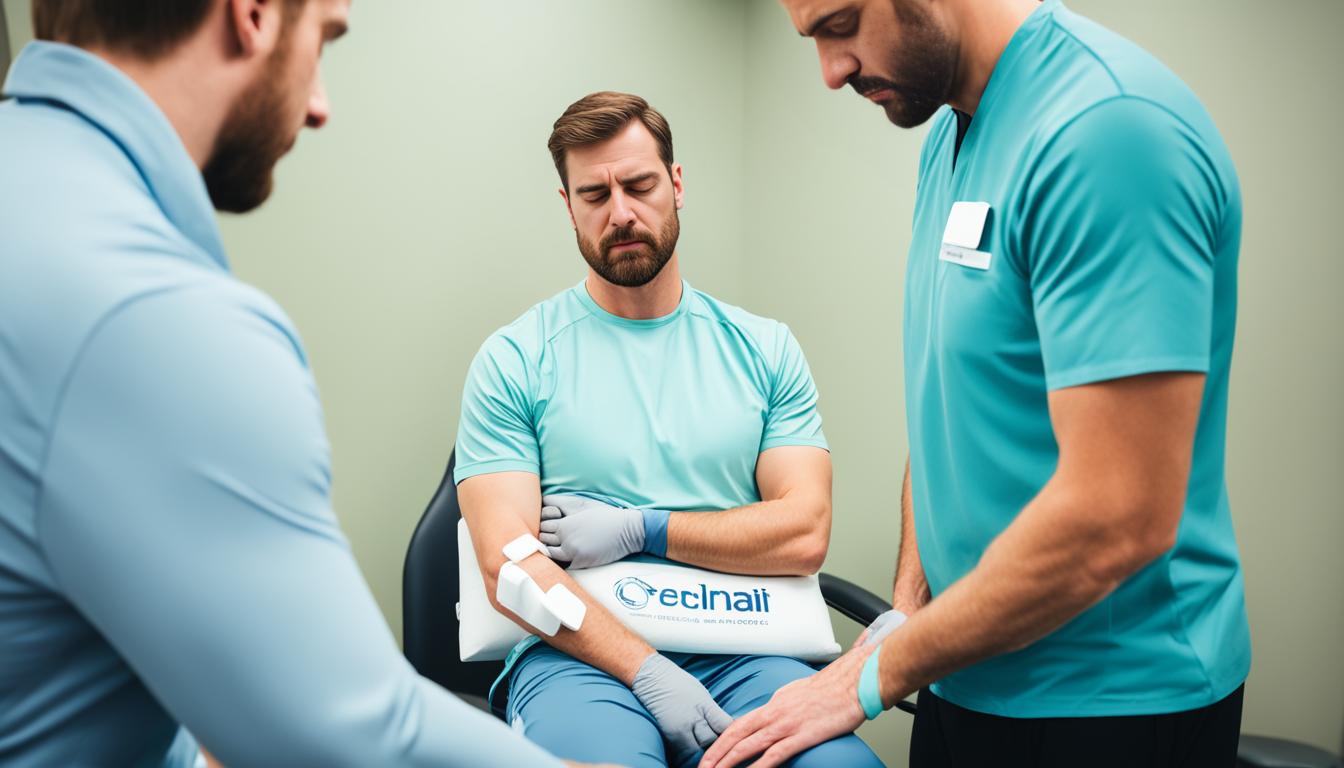In this comprehensive guide, we will explore a range of effective shoulder therapy techniques that can help you regain mobility, ease pain, and prevent future injuries. Whether you’re dealing with a nagging rotator cuff issue, frozen shoulder, or simply want to improve your overall shoulder health, our expert-backed strategies will provide you with the tools and knowledge to take control of your recovery.
Key Takeaways
- Discover a variety of effective shoulder therapy techniques to address various shoulder conditions.
- Learn how to regain mobility, reduce pain, and prevent future shoulder injuries through targeted exercises and therapies.
- Explore specialized treatments for conditions like frozen shoulder and shoulder impingement.
- Understand the importance of proper posture and ergonomic support for long-term shoulder health.
- Incorporate complementary therapies like heat, cold, and massage to enhance the effectiveness of your shoulder rehabilitation.
Understanding Shoulder Pain and Injuries
To effectively address shoulder pain and improve your overall shoulder health, it’s crucial to first understand the common causes of shoulder discomfort and the intricate anatomy of the shoulder joint. By delving into the most prevalent shoulder conditions, such as rotator cuff injuries, frozen shoulder, and shoulder impingement, we can explore how the complex structure of the shoulder can contribute to these issues.
Common Causes of Shoulder Discomfort
Shoulder pain and injuries can stem from a variety of factors, including overuse, traumatic events, or underlying medical conditions. Some of the most common causes of shoulder discomfort include rotator cuff tears, frozen shoulder, and shoulder impingement. Understanding the specific mechanisms behind these shoulder problems can help us develop targeted shoulder therapy strategies for relief and recovery.
Anatomy of the Shoulder Joint
The shoulder joint is a complex and intricate structure, composed of several bones, muscles, tendons, and ligaments. The rotator cuff, a group of four muscles and their associated tendons, plays a crucial role in stabilizing the shoulder and enabling a wide range of motion. When the delicate balance of the shoulder joint is disrupted, it can lead to painful shoulder injuries and reduced mobility. Exploring the anatomy of the shoulder can provide valuable insights into the underlying causes of various shoulder conditions.
The Benefits of Shoulder Therapy
Engaging in shoulder therapy can provide a range of benefits that can significantly improve your overall shoulder health and well-being. By understanding the potential outcomes of shoulder therapy, you’ll be better equipped to make informed decisions about your treatment plan and work towards a successful recovery.
Reducing Pain and Inflammation
One of the primary goals of shoulder therapy is to reduce pain and inflammation in the affected area. Through a combination of targeted exercises, manual therapy techniques, and the incorporation of complementary therapies like heat and cold application, shoulder therapy can help alleviate discomfort and improve your overall quality of life.
Improving Range of Motion
Restricted range of motion in the shoulder joint can be a debilitating consequence of various shoulder injuries and conditions. Shoulder therapy, which often includes stretching and joint mobilization exercises, can help restore flexibility and enhance your ability to move your shoulder freely, enabling you to regain the mobility you need to perform daily tasks and engage in physical activities with ease.
Regaining Strength and Stability
In addition to improving flexibility, shoulder therapy focuses on rebuilding the strength and stability of the shoulder joint. Through targeted strengthening exercises that target the rotator cuff and surrounding muscle groups, you can gradually restore the support and control needed to prevent future injuries and maintain proper shoulder function.
By addressing the root causes of shoulder discomfort and implementing a comprehensive shoulder therapy plan, you can experience the benefits of pain relief, improved mobility, and enhanced shoulder strength and stability. This holistic approach to shoulder care can help you regain your active lifestyle and enjoy a greater sense of shoulder therapy benefits.
Shoulder Therapy Techniques
Achieving effective shoulder therapy often involves a combination of stretching and strengthening exercises tailored to your specific needs. In this section, we’ll explore a range of proven techniques that can help you regain mobility, enhance stability, and reduce the risk of future shoulder injuries.
Stretching Exercises for Flexibility
Improving shoulder flexibility is crucial for restoring range of motion and reducing the strain on the joint. Our experts recommend a variety of stretching exercises, such as the shoulder roll, the standing shoulder stretch, and the doorway pectoral stretch. Incorporating these shoulder stretches into your routine can help alleviate tightness and improve your overall shoulder flexibility.
Strengthening Exercises for Rotator Cuff
The rotator cuff muscles play a vital role in stabilizing the shoulder joint and maintaining proper shoulder function. To target these key muscle groups, we suggest rotator cuff exercises like the shoulder external rotation, the lying shoulder raise, and the standing shoulder abduction. By consistently performing these shoulder strengthening exercises, you can build the necessary stability and support for your shoulder joint.
By combining these shoulder therapy techniques, you can regain the mobility, strength, and stability needed to enjoy a pain-free and active lifestyle. Remember to consult with a healthcare professional to ensure that your exercise program is tailored to your unique needs and goals.
Postural Correction and Ergonomics
Maintaining proper posture and ergonomic support is crucial for shoulder health. Poor posture habits can contribute to shoulder discomfort and increase the risk of future injuries. In this section, we’ll explore strategies to identify and correct these problematic postural patterns, as well as practical ergonomic adjustments you can make to your workstation.
Identifying Poor Posture Habits
The first step in improving your shoulder health is to recognize the signs of poor posture. Common indicators include rounded shoulders, a forward-leaning head, and a hunched back. These posture issues can put strain on the shoulder muscles and joints, leading to pain and reduced mobility.
To assess your posture, stand in front of a mirror and observe your body alignment. Alternatively, ask a friend or family member to provide an objective assessment. Once you’ve identified the areas needing improvement, you can begin incorporating targeted exercises and adjustments to correct these habits.
Ergonomic Adjustments for Workstations
If you spend a significant portion of your day sitting at a desk, the design and setup of your workstation can significantly impact your shoulder health. Poorly adjusted chairs, desks, and computer monitors can contribute to poor posture and exacerbate shoulder discomfort.
To optimize your workstation ergonomics, consider the following adjustments:
- Ensure your chair provides adequate lumbar support and allows your feet to rest flat on the floor.
- Adjust the height of your desk or computer monitor so that your eyes are level with the top third of the screen.
- Position your keyboard and mouse within easy reach, maintaining a neutral wrist position.
- Use a footrest or adjustable desk to elevate your legs and promote better spinal alignment.
By making these simple ergonomic changes, you can alleviate shoulder strain and improve your overall posture, helping to prevent future issues and promote a more comfortable and productive work environment.

Shoulder Therapy for Specific Conditions
While the general principles of shoulder therapy can be applied to a wide range of shoulder conditions, some issues may require more specialized treatment approaches. In this section, we’ll delve into the specific considerations and therapies for two common shoulder problems: frozen shoulder and shoulder impingement.
Frozen Shoulder Treatment
Frozen shoulder, also known as adhesive capsulitis, is a condition characterized by stiffness, pain, and restricted range of motion in the shoulder joint. This debilitating condition can develop gradually, making it difficult to perform even basic daily activities. Effective frozen shoulder treatment often involves a combination of targeted exercises, manual therapy techniques, and in some cases, corticosteroid injections. Our team of shoulder therapy experts will work closely with you to develop a personalized treatment plan that addresses the underlying causes of your frozen shoulder and helps you regain mobility and function.
Shoulder Impingement Therapy
Shoulder impingement is another common shoulder condition that can cause pain, inflammation, and limited range of motion. This issue occurs when the tendons or bursa within the shoulder joint become irritated or compressed, often due to repetitive overhead movements or poor posture. Shoulder impingement therapy typically focuses on strengthening the rotator cuff muscles, improving scapular stabilization, and addressing any underlying biomechanical imbalances. Our specialized treatments will help alleviate your shoulder impingement symptoms and prevent the condition from becoming a chronic issue.
| Condition | Key Characteristics | Specialized Treatments |
|---|---|---|
| Frozen Shoulder | Stiffness, pain, and restricted range of motion in the shoulder joint | Targeted exercises, manual therapy techniques, corticosteroid injections |
| Shoulder Impingement | Pain, inflammation, and limited range of motion due to irritated or compressed tendons or bursa | Strengthening rotator cuff muscles, improving scapular stabilization, addressing biomechanical imbalances |
By understanding the unique needs of these specific shoulder conditions, you can make more informed decisions about your treatment plan and work towards a successful recovery.
Complementary Therapies
While the core shoulder therapy techniques are crucial for addressing pain, improving mobility, and regaining strength, incorporating complementary therapies can amplify the effectiveness of your treatment plan. In this section, we’ll explore the benefits of heat and cold therapy, as well as the role of massage in promoting shoulder healing and recovery.
Heat and Cold Therapy
Heat and cold therapy can be powerful allies in your shoulder therapy journey. Heat therapy, such as applying warm compresses or using heating pads, can help increase blood flow, reduce muscle tension, and alleviate pain. Conversely, cold therapy, like ice packs or cryotherapy, can reduce inflammation and numb discomfort, providing immediate relief. By strategically incorporating both heat and cold treatments into your routine, you can create a comprehensive approach to managing shoulder therapy.
Massage Techniques
Massage therapy can be a valuable complement to your shoulder therapy regimen. Skilled massage therapists can target the specific muscles, tendons, and connective tissues surrounding the shoulder joint, promoting relaxation, improving circulation, and facilitating the healing process. Techniques such as deep tissue massage, myofascial release, and trigger point therapy can help address areas of tension, release adhesions, and restore flexibility to the shoulder.
By integrating these complementary therapies into your shoulder therapy plan, you can enhance the overall effectiveness of your treatment and achieve greater relief and improved shoulder function. Remember to consult with your healthcare provider or a trained specialist to ensure the safe and appropriate use of these complementary approaches.

Shoulder Therapy Aftercare
Achieving successful outcomes from shoulder therapy is not just about the treatment itself, but also the aftercare and maintenance phase. To ensure that the gains made during your shoulder therapy are sustained over time, it’s crucial to prioritize continued exercises, lifestyle adjustments, and ongoing monitoring.
After your shoulder therapy sessions, your healthcare provider will likely recommend a personalized aftercare plan to help you maintain the progress you’ve achieved. This may include a combination of shoulder exercises, lifestyle modifications, and regular check-ups to monitor your shoulder recovery and maintenance.
Incorporating the prescribed shoulder therapy exercises into your daily routine is essential for preserving your range of motion, strength, and overall shoulder health. Your physical therapist or healthcare provider will guide you through the appropriate exercises and provide instructions on proper technique to ensure you’re performing them safely and effectively.
In addition to continuous exercise, making adjustments to your daily activities and work environment can also contribute to the long-term success of your shoulder therapy. This may involve ergonomic changes, posture corrections, and adopting habits that minimize stress on your shoulder joint.
Regular check-ins with your healthcare provider are also crucial during the aftercare phase. These follow-up appointments allow your provider to assess your progress, identify any emerging issues, and make necessary adjustments to your treatment plan. By staying proactive and engaged in your shoulder recovery and maintenance, you can ensure that the benefits of your shoulder therapy continue to positively impact your overall well-being.
| Aftercare Component | Purpose |
|---|---|
| Continued Shoulder Exercises | Maintain range of motion, strength, and shoulder health |
| Lifestyle Modifications | Minimize stress on the shoulder joint and promote overall well-being |
| Regular Check-ups | Monitor progress, identify issues, and adjust treatment plan as needed |
By prioritizing shoulder therapy aftercare and embracing a comprehensive approach to your recovery and maintenance, you can ensure that the progress you’ve made during your shoulder therapy sessions continues to benefit you in the long run, allowing you to enjoy a more active and pain-free lifestyle.
Preventing Future Shoulder Injuries
As we’ve explored the various shoulder therapy techniques and approaches, it’s important to remember that the ultimate goal is not just to address current issues, but also to prevent future shoulder injuries from occurring. By adopting proactive measures, we can safeguard our shoulders and continue to enjoy an active and healthy lifestyle.
Maintaining Proper Form During Exercise
One of the most crucial steps in preventing future shoulder injuries is to maintain proper form during our exercises. Whether we’re performing strength training, stretching, or any other shoulder-related activity, it’s essential to ensure that we’re engaging the correct muscle groups and avoiding any movements that could place unnecessary strain on the shoulder joint. By focusing on proper technique, we can minimize the risk of developing overuse injuries or exacerbating existing conditions.
Incorporating Cross-Training
Another effective strategy for preventing future shoulder injuries is to incorporate cross-training activities into our routine. By engaging in a variety of exercises that target different muscle groups, we can help to balance out the demands on our shoulders and reduce the risk of imbalances or overuse. This could include activities such as swimming, cycling, or even yoga, which can complement our shoulder therapy exercises and promote overall musculoskeletal health.

